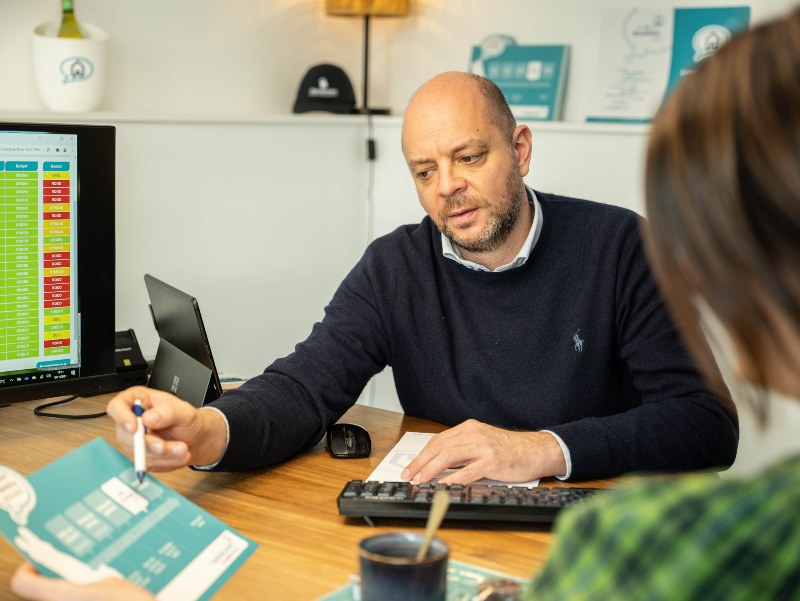How much can I borrow?
Can I now go house-hunting with confidence?
No, actually.
It remains, like everywhere else on the internet, just a simple calculation tool that gives an initial direction, but don’t get hung up on it.
We’ll be happy to make an overview for you in a personal conversation without overlooking any details of your financial situation. A difference that seems small at first glance (meal vouchers, company car, holiday pay, etc.) can have major consequences for the total budget of your mortgage loan. For example, the simulation above may be wrong by several tens of thousands of euros.
Do you want real certainty about how much you can actually borrow for your home? Then it’s best to make an appointment with us so you can start house-hunting without any doubts.
Why is such an appointment at hypotheek.winkel useful?
How much can I borrow? Yes, that’s the first question home-seekers ask, of course. One that we at hypotheek.winkel can only answer with further questions. We prefer to take our time, rather than letting you go house-hunting with false hopes or – perhaps just as bad – with too much anxiety.
To get started, we need to reframe the question to “how much can you pay off?” This is because there is no maximum amount on how much you can borrow. Whether it’s an apartment, a farmhouse or an art nouveau city palace, the bank’s inclination to open the money taps depends solely on your creditworthiness. A young bachelor with no savings will have a harder time borrowing for a workman’s cottage than a settled couple of lawyers for an expensive loft apartment.
Question one: how much can you afford?
Because nobody has a crystal ball, the bank can only go on your current financial situation and possibly that of your partner. To calculate your ‘ability to repay’, as it’s known, they look at what comes in and what goes out each month. Your wage versus your expenses, that is.
That means the bank is actually going in pretty blind. You could well be spending every night at the casino or dining out at fancy restaurants, and they wouldn’t take any account of that. They only look at what recurs each month, like a car loan or a fixed alimony. Well, what does that tell them? Income can also be difficult to demonstrate. A self-employed person starting out, for example, who is still investing heavily and earning irregularly, will therefore often find it harder to get a loan than someone who is employed.
What monthly cost feels right to you? You’re best off doing the maths yourself. Think of the major annual expenses in particular, such as (car) insurance, a trip abroad or perhaps an expensive hobby. You know far better than the bank what you really spend. Add up both your income and expenses and divide these by twelve. Note: you still have to live, of course (food, clothes, energy, etc.) so that figure is certainly not what you can throw at your home.
The difference between the two is your ability to repay.
Question two: how much does your home really cost?
The price on Immoweb is not the price of the home. In addition to the purchase price, there’s also the registration fees, the notary’s fees and the cost of the loan itself (do the full simulation here).You’ll probably also need to take out outstanding balance insurance and fire insurance. All in all, you should assume an average of 10% of the purchase price. Good to know: you have to pay for all that, but for the bank, it’s not part of the price of the home. So you can’t borrow for it.
What’s more, the bank will also expect a contribution from you. For a first family home, they’ll be willing to lend up to 90% of the purchase price for the home, by and large. So for a 300,000-euro home, you’ll rarely be able to borrow more than 270,000 euros. Add to the missing 30,000 euros those 10% costs from before, and you already need some substantial savings of 60,000 euros…Fortunately, there are solutions we can help you with.
Question three: for how long do you want to pay?
In addition, the payment term for the loan also plays a role. A 10-year loan won’t be very common for a home loan, but how do you choose between 20, 25 or 30 years? That’s a real balancing act. If you pay for longer, you’ll pay less per month, but pay more interest to the bank. If you want to keep the term as short as possible, you’ll be better off in the long-term, but you may be eating jam sandwiches by the end of the month.
Back to our example from before: how much will you pay per month for that loan of 270,000 euros over 20, 25 or 30 years? At a fixed interest rate of 2%, disregarding additional costs and whether the planets have aligned:
20 years: 1,365 euros / month (total repayment: 328,000 euros)
25 years: 1,144 euros / month (total repayment: 343,000 euros)
30 years: 998 euros / month (total repayment: 359,000 euros)
Bonus question: what if I don’t know yet?
You can find many tools online to estimate your ability to repay and your monthly costs. But they’re not very accurate, because they don’t ask enough questions. At the end of the day, your personal situation is more complicated than five input boxes.
You can ask your banker for advice, but of course they’ll only know the options at their own bank. Why don’t you ask to speak to an independent expert? At hypotheek.winkel it’s free, and you can be sure there’s no hidden agenda involved.

